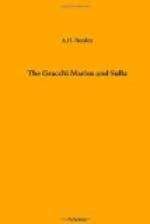After this narration of the military events of the period to the beginning of the second century B.C., it is natural to consider the changes which Marius had effected in the army—the instrument of his late conquests. [Sidenote: Changes in the Roman army.] We cannot tell how many of the innovations now introduced were initiated by him, but they were introduced about this date. Before his time the Hastati, Principes, and Triarii, ranked according to length of service, had superseded the Servian classes. From his time this second classification also ceased. [Sidenote: Arms of the legionary.] Every legionary was armed alike with the heavy pilum—an iron-headed javelin 6 feet 9 inches long, the light pilum, a sword, and a coat of armour. Besides these he had to carry food and other burdens, which would vary according to the length and object of the march, such as stakes for encampment, tools, &c. [Sidenote: The ‘Marian mules.’] Marius invented what were called ‘Mariani muli’ to ease the soldier—forked sticks, with a board at the end to bear the bundle, carried over the shoulders. Before his time the army had ceased to be recruited solely from Roman citizens. Not only had Italians been drafted into it, but foreign mercenaries were employed, such as Thracians, Africans, Ligurians, and Balearians. [Sidenote: The light troops auxiliaries.] After his time the Velites are not mentioned, and all the light-armed troop were auxiliaries. [Sidenote: The cohort the tactical unit.] Before his time the maniple had been the tactical unit. Now it was the cohort. [Sidenote: Composition of the legion.] A legion consisted of ten cohorts, each cohort containing three maniples, and each maniple two centuries. The legion’s standard was the eagle, borne by the oldest centurion of the first cohort. Each cohort had its ‘signum,’ or ensign. [Sidenote: Standards.] Each maniple had its ‘vexillum,’ or standard. [Sidenote: Officers.] There were two centurions for each maniple, one commanding the first and the other the second century, and taking rank according to the cohort to which they belonged, which might be from the first to the tenth. The youngest centurion officered the second century of the third maniple of the tenth cohort. The oldest officered the first century of the first maniple of the first cohort, and was called ‘primus-pilus,’ and the ‘primi ordines,’ or first class of centurions, consisted of the six centurions of the first cohort. These corresponded to our non-commissioned officers, were taken from the lower classes of society, and were seldom made tribunes. [Sidenote: The tribunes.] The tribunes were six to each legion, were taken from the upper class, and after being attached to the general’s suite, received the rank of tribune, if they were supposed to be qualified for it. The tribunes were originally appointed by the consuls. Afterwards they had been elected, partly by the people and partly by the consuls. Caesar superseded the tribunes by ‘legati’




